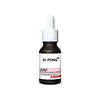What's inside
What's inside
 Key Ingredients
Key Ingredients

 Benefits
Benefits

 Concerns
Concerns

No concerns
 Ingredients Side-by-side
Ingredients Side-by-side

Water
Skin ConditioningBiosaccharide Gum-1
HumectantHydroxyethylcellulose
Emulsion StabilisingHydroxypropyl Guar
Emulsion StabilisingNiacinamide
SmoothingHydroxyethyl Urea
HumectantGlycerin
HumectantGluconobacter/Honey Ferment Filtrate
Skin ConditioningSaccharide Isomerate
HumectantGlycine Soja Seed Extract
Skin ConditioningButylene Glycol
HumectantSilanediol Salicylate
EmollientGluconolactone
Skin ConditioningPotassium Azeloyl Diglycinate
Skin ConditioningCapryloyl Salicylic Acid
ExfoliatingSophora Angustifolia Root Extract
Skin ConditioningArbutin
AntioxidantAcetyl Tyrosine
Skin ConditioningSaxifraga Sarmentosa Extract
Skin ConditioningPaeonia Suffruticosa Root Extract
Skin ProtectingAminopropyl Ascorbyl Phosphate
AntioxidantScutellaria Baicalensis Root Extract
AstringentGlutathione
Allantoin
Skin ConditioningSodium Hyaluronate
HumectantLinolenic Acid
CleansingXanthan Gum
EmulsifyingPolyvinyl Alcohol
Glycolic Acid
BufferingLactic Acid
BufferingSodium Ascorbyl Phosphate
AntioxidantPalmitoyl Sh-Tripeptide-5 Norisoleucyl Sh-Nonapeptide-1
Skin ConditioningSodium Polyacrylate
AbsorbentEthylhexyl Stearate
EmollientTrideceth-6
EmulsifyingPolyacrylate Crosspolymer-6
Emulsion StabilisingHydroxyacetophenone
AntioxidantCaprylyl Glycol
EmollientDipropylene Glycol
HumectantDipotassium Glycyrrhizate
HumectantWater, Biosaccharide Gum-1, Hydroxyethylcellulose, Hydroxypropyl Guar, Niacinamide, Hydroxyethyl Urea, Glycerin, Gluconobacter/Honey Ferment Filtrate, Saccharide Isomerate, Glycine Soja Seed Extract, Butylene Glycol, Silanediol Salicylate, Gluconolactone, Potassium Azeloyl Diglycinate, Capryloyl Salicylic Acid, Sophora Angustifolia Root Extract, Arbutin, Acetyl Tyrosine, Saxifraga Sarmentosa Extract, Paeonia Suffruticosa Root Extract, Aminopropyl Ascorbyl Phosphate, Scutellaria Baicalensis Root Extract, Glutathione, Allantoin, Sodium Hyaluronate, Linolenic Acid, Xanthan Gum, Polyvinyl Alcohol, Glycolic Acid, Lactic Acid, Sodium Ascorbyl Phosphate, Palmitoyl Sh-Tripeptide-5 Norisoleucyl Sh-Nonapeptide-1, Sodium Polyacrylate, Ethylhexyl Stearate, Trideceth-6, Polyacrylate Crosspolymer-6, Hydroxyacetophenone, Caprylyl Glycol, Dipropylene Glycol, Dipotassium Glycyrrhizate
Water
Skin ConditioningGlycerin
HumectantPotassium Azeloyl Diglycinate
Skin ConditioningButylene Glycol
HumectantTranexamic Acid
AstringentAlpha-Arbutin
AntioxidantBiosaccharide Gum-1
HumectantSodium Polyacryloyldimethyl Taurate
Emulsion StabilisingPolyacrylate Crosspolymer-6
Emulsion StabilisingChlorphenesin
AntimicrobialPhenoxyethanol
PreservativeSodium Metabisulfite
AntioxidantSodium Diethylenetriamine Pentamethylene Phosphonate
Sodium Gluceptate
Trehalose
HumectantDisodium EDTA
Sodium Hyaluronate
HumectantWater, Glycerin, Potassium Azeloyl Diglycinate, Butylene Glycol, Tranexamic Acid, Alpha-Arbutin, Biosaccharide Gum-1, Sodium Polyacryloyldimethyl Taurate, Polyacrylate Crosspolymer-6, Chlorphenesin, Phenoxyethanol, Sodium Metabisulfite, Sodium Diethylenetriamine Pentamethylene Phosphonate, Sodium Gluceptate, Trehalose, Disodium EDTA, Sodium Hyaluronate
Ingredients Explained
These ingredients are found in both products.
Ingredients higher up in an ingredient list are typically present in a larger amount.
Biosaccharide Gum-1 is a sugar created by fermenting sorbitol (which usually comes from potato starch!). It is known for its soothing and moisturizing properties.
Manufacturer tests show this ingredient helped reduce irritation from lactic acid by almost half and kept skin hydrated long-term as a humectant
Beyond hydration, Biosaccharide Gum-1 gives formulas a silky, non-sticky feel.
This ingredient is gentle, versatile, and suitable for all skin types.
Fun fact: Similar sugars can be found naturally in fruits like apples and pears.
Learn more about Biosaccharide Gum-1Butylene Glycol (or BG) is used within cosmetic products for a few different reasons:
Overall, Butylene Glycol is a safe and well-rounded ingredient that works well with other ingredients.
Though this ingredient works well with most skin types, some people with sensitive skin may experience a reaction such as allergic rashes, closed comedones, or itchiness.
Learn more about Butylene GlycolGlycerin is already naturally found in your skin. It helps moisturize and protect your skin.
A study from 2016 found glycerin to be more effective as a humectant than AHAs and hyaluronic acid.
As a humectant, it helps the skin stay hydrated by pulling moisture to your skin. The low molecular weight of glycerin allows it to pull moisture into the deeper layers of your skin.
Hydrated skin improves your skin barrier; Your skin barrier helps protect against irritants and bacteria.
Glycerin has also been found to have antimicrobial and antiviral properties. Due to these properties, glycerin is often used in wound and burn treatments.
In cosmetics, glycerin is usually derived from plants such as soybean or palm. However, it can also be sourced from animals, such as tallow or animal fat.
This ingredient is organic, colorless, odorless, and non-toxic.
Glycerin is the name for this ingredient in American English. British English uses Glycerol/Glycerine.
Learn more about GlycerinPolyacrylate Crosspolymer-6 is a texture enhancer and pH adjuster.
It is be used to thicken water-based products and create a gel-texture with a velvet feel.
One manufacturer claims this ingredient to have a pH range of 2-8 and to be biodegradable.
Learn more about Polyacrylate Crosspolymer-6Potassium Azeloyl Diglycinate (PAD) comes from the condensation of azelaic acid mixed with glycine.
This ingredient has similar properties to azelaic acid; it can help reduce sebum production and soothe skin. PAD also inhibits tyrosinase activity to help brighten skin. Tyrosinase is an enzyme that controls melanin production.
A study from 2023 found 5% PAD combined with nicotinamide (a form of niacin) effectively reduced melanin production after 6 weeks.
Several studies from the 2010's also show PAD to be effective in alleviating symptoms of Rosacea.
Though this ingredient is considered a gentle active, higher amounts may result in irritation.
Unlike azelaic acid, this ingredient is water-soluble. This property makes it easier to formulate into skincare products.
Learn more about Potassium Azeloyl DiglycinateSodium Hyaluronate is hyaluronic acid's salt form. It is commonly derived from the sodium salt of hyaluronic acid.
Like hyaluronic acid, it is great at holding water and acts as a humectant. This makes it a great skin hydrating ingredient.
Sodium Hyaluronate is naturally occurring in our bodies and is mostly found in eye fluid and joints.
These are some other common types of Hyaluronic Acid:
Learn more about Sodium HyaluronateWater. It's the most common cosmetic ingredient of all. You'll usually see it at the top of ingredient lists, meaning that it makes up the largest part of the product.
So why is it so popular? Water most often acts as a solvent - this means that it helps dissolve other ingredients into the formulation.
You'll also recognize water as that liquid we all need to stay alive. If you see this, drink a glass of water. Stay hydrated!
Learn more about Water